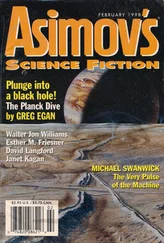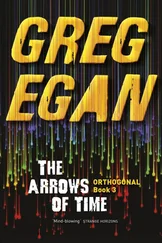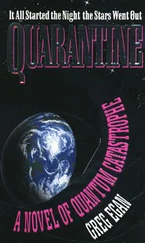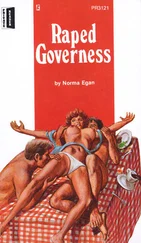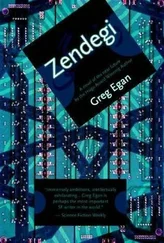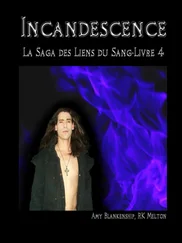Her checkers stirred, and patiently resumed their places. She dared to cast a glance at Tan; his posture seemed optimistic. She was not fooling herself, then. They had not become lost in this maze of symbols.
Roi pushed on to extract the other results. The period of the orbit, the ratios of the weights were much more complicated templates than before. Roi found them ugly, but that didn't prove that they were wrong.
This time, as well as determining the size of the Splinter's orbit — compared to a still unknowable natural unit — she would need to quantify the twisting of the geometry around the Hub. The two were entangled in the templates, but taken together, their newest observation, the ratio of the Splinter's orbital period to the shomal-junub cycle, and their oldest, the ratio of the weights, could unlock the numbers.
Roi finished the calculation, but couldn't bring herself to pass on the frame for checking. She was sure she had made a mistake. The amount of the twist, in natural units, was very close to one. She had no real idea what that meant, but at least it was simple.
The size of the Splinter's orbit, though, was not eight, as before, but barely more than two . It was true that the orbits could not be compared directly between the geometries, but surely an orbit four times smaller was impossible. Wasn't an orbit of size six unstable?
The answer turned out to be: not any more. In this new geometry, orbits in the direction of the twist remained stable right down to a size of one unit. The marker for danger remained the behavior of a looping stone, but the link between the shape of the loop and the size of the orbit had changed completely.
Roi didn't know if this was good news or bad. They were four times closer to the Hub than they'd imagined, but they could survive a further halving of their distance, rather than losing a quarter of it.
She passed the last frame to her checkers and stretched out against the rock. She looked over at Tan; he'd finished too.
She waited for the final verdict. There was some confusion; she and Tan had expressed their results differently, because his way of describing the orbit size was not the same as hers. The checkers worked through the conversion, then announced a perfect concordance.
Roi was elated that they'd made it through the ordeal and emerged with answers that made sense, but she needed to remain cautious. They had shown that a geometry with rotational symmetry, and which obeyed Zak's principle, was possible. That was a beautiful result that they had never been certain of before. However, the freedom to set the twist in the geometry to whatever number they wished meant that they hadn't really subjected their theory to a meaningful test. One new observation, the period of the orbit, had been absorbed entirely by the need to pin down that new unknown, the twist.
Tan approached her.
"Well done!" he chirped.
"You too."
"I'm glad we made different choices," he said. "We should keep the two systems; it will allow us to cross-check everything between them."
Roi said, "We need to start thinking about the other observations from the void: the lights, the motion of the Wanderer. Once we've thrown all those numbers at this geometry, we'll know if it's real."
Tan let his legs sag comically. "I need a break," he pleaded. "At least one shift doing nothing."
The checkers dispersed to gather food. In spite of his protests, Tan lingered, poring over the templates with her, trying to understand what the new geometry meant.
He said, "When you carry the direction of the Rotator's plane around a loop in curved space-time, it comes back changed. So the period of our spin is different from the period of our orbit; even the old geometry predicted that. But in this geometry, even if the Splinter didn't orbit —if it was held at a fixed position, with the garm-sard axis pointing toward the Hub — we would still feel a spin weight, and the Rotator would still turn!"
Roi checked; he was right. If you took a direction pointing toward the Hub, and simply carried it forward in time, it turned away from the Hub. The only way to feel as if you were not turning was to spin along with it, like the Rotator.
"It's all very strange," she said. A little later, she noticed something else. "If your distance from the Hub is two or less, it becomes impossible not to move in an orbit! To try to stay still means moving faster than the fastest possible speed!"
Roi followed the geometry inward, closer to the Hub. At a distance of one, as she'd already calculated, the looping stones would stop looping: the smallest disturbance would topple you from your orbit. But something else happened there, too: staying at a fixed distance from the Hub became, not just unlikely, but impossible. Orbits weren't merely unstable, they ceased to exist at all. The only kind of motion that was allowed was inward. Every path, natural or otherwise, led inexorably straight to the Hub.
Tan said, "It would be a quick death, I think. The garm-sard weight would grow so fast that our bodies would be torn apart before we could feel much pain."
"Better than burning in the heat of the Wanderer?" By moving the Splinter outward, that was the fate they were risking.
"Where did this madness come from?" she asked. "If we work hard, our lives should be good. Some sickness, some famine, that can't be avoided. But for all of us to die, how could that be possible?"
Tan said quietly, "Nobody can understand these things."
"I won't let our children live like this!" Roi declared. "When this is finished. " She trailed off impotently. She would do what? Banish every future Wanderer that might disturb their tranquility? Build a wall across the void?
"If we keep working," Tan said, "our lives will be safer. We need to keep thinking, calculating, watching the void. But this work will never be finished. There will never be a time when we can go back to the old ways and expect to be safe."
After a rest shift, Roi met with Tan again to plan the way forward. Their ultimate goal was to understand the geometry well enough to be able to map out a safe path past the Wanderer, but they still lacked the mathematical tools to calculate anything except for circular orbits in the plane of the Incandescence.
The observations of the void held the key, both to validating the new geometry itself and to understanding what kind of paths were possible. If they could fit the motion of the Wanderer into the picture, Roi was sure everything would become clearer. But to make use of their observations, they needed to understand the paths that the light they were seeing had taken through the curved geometry, which was every bit as hard a problem as working out the path of the Wanderer itself. It wasn't quite a vicious circle, but the way to break in was not easy or obvious.
Three shifts later they were still getting nowhere, when a young recruit appeared at the entrance to the chamber.
"Excuse me," she said. "I think I've found something."
Her name was Kem; Tan introduced her to Roi. He'd given copies of Roi's observations from the void to all the recruits who'd finished their studies in template geometry, and set them the task of finding a way to interpret them.
"I've been thinking about symmetries," Kem said. "If you look at the relationship between the direction of a natural path and a motion of symmetry, it should be the same all along the path." The idea, she explained, wasn't tied to the particular geometry they'd discovered; it followed from the very definition of symmetry.
A simple example made Kem's proposition more persuasive. On the surface of a perfectly round stone, the natural paths were great circles: the circles whose centers were the centers of the stone itself. The symmetries were rotations around any axis you cared to name. If you chose a particular great circle to be your natural path, then chose a diameter of that circle as the axis of rotation, the motion of symmetry — the way points on the surface shifted when the stone was rotated — would be perpendicular to the direction of the path, everywhere. If instead you chose an axis of rotation perpendicular to the plane of the great circle, the motion of symmetry would agree with the direction of the natural path, all along its length. And if you picked an axis that lay between those extremes, then although the angle between the motion of symmetry and the direction of the path would change, the size of the motion would also change, growing ever larger as the two drifted away from being parallel, in just the right way to compensate. Between the two effects, a number could be computed that would remain identical all along the path.
Читать дальше

